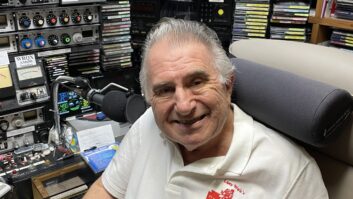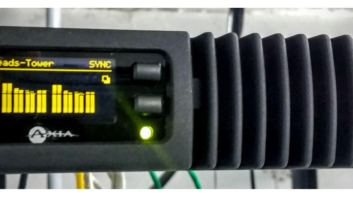For the most part, tower insulators are pretty rugged. I’ve been in this business for more than 35 years and have never seen a base insulator fail — or even crack … until recently.
Porcelain is a rugged material that is very durable in compression; it does not crush. That makes it an excellent material for use in high weight-bearing applications (such as under a tower). The same material is used for guy wire insulators in AM applications, with the guy cable rigged through the insulators so that they compress the porcelain material and don’t pull on it.

Cracks and discoloration are visible on the lower section of the southwest insulator.
In guyed AM tower applications, a cone-shaped or cylindrical insulator is placed between the base pier and the tower base plate with the full weight of the tower compressing the material of the insulator.
Free-standing towers are a little different because they have both downward and upward moments, depending on the direction and velocity of the wind. As such, base insulators under the legs of a free-standing tower have to work in both directions, both supporting the weight of the tower and holding the tower leg to the foundation, depending on instantaneous conditions. That double duty requires a special design, usually a pair of porcelain insulators held captive in a steel or iron frame. The lower insulator supports the tower leg’s weight while the upper holds the tower leg down.
A BURNING SUSPICION
In my company, we have a number of “legacy” AM signals, and some of these employ free-standing towers with this type of dual insulator design. Some of these towers and insulators date back to the mid-1930s, a testament to their toughness and durability.
Base insulators have to operate out in the elements, providing isolation between the metal members above and the ground below in all kinds of conditions — wet, dry, dirty and clean. It’s almost unheard of for a properly-selected base insulator to arc over due to RF excitation or a combination of RF plus static electricity. Ball gaps are usually provided across the base insulator to provide a discharge path for static and lightning away from the porcelain material of the insulator.

The lifting bracket is visible with the insulator assembly out.
There was, however, a day when it happened to our Portland AM station, KKPZ.
Our station operates with 5 kW full-time using a three-tower directional antenna. The two 310-foot and one 437-foot free-standing towers date to the early 1960s. Radio Disney operates its expanded-band KDZR with 10 kW-day/1 kW-night into tower #3 of the array, which is one of the 310-foot towers and the low-power tower of the KKPZ directional array.
We were wrapping up a tower painting project awhile back when at the end of a workday, our chief engineer noticed paint overspray on the porcelain surface of two of the base insulators under tower #3. He notified the tower crew and they wiped the insulators down with a wet rag.
The next morning was foggy and everything was soggy-wet. When our engineer arrived at the site early that day, he was greeted by one of the tower crew asking, “Are those base insulators supposed to be steaming?” Our engineer noted that indeed there were copious amounts of steam rising from two of the insulators, and from his vantage point in the parking area he saw what appeared to be a sustained plasma arc dancing over the surface of the nearest insulator.
He quickly went into the building and shut off the transmitters, which immediately extinguished the arcs. He and the tower crew examined the base insulators and found carbon tracks and cracks on the two insulators that had been contaminated with overspray and cleaned.
The insulators were thoroughly cleaned and everyone held their breath as RF excitation was applied. To our great relief, the insulators held; there was no more arcing.
The question at that point: Were the cracks simply in the glazing on the surface or did they go deeper? Was this a cosmetic or a structural issue? (See photo above.)
DON’T TIP THAT THING OVER

One of the completed insulator replacements, ready for priming and painting … without the overspray! Note the bare metal adapter plate bolted to the tower leg.
Replacing a base insulator is a big deal, especially on a self-supporting tower. With a guyed tower it’s possible to loosen the guy wires and “pick” the tower with a crane or lift it with a jack, gaining enough clearance to rotate the old insulator out and the new one in.
Not so with a self-supporting tower. The forces on all three or four legs are in balance. You can’t just use a crane or jack to lift one leg without providing some means of also holding the leg down. Once the bolts that hold the insulator assembly are out, if there is nothing holding the tower leg down, a gust of wind on that side of the tower could well topple the structure.
All that was taken into consideration as we evaluated whether to replace the insulators immediately. We decided to wait and see whether any evidence of structural problems would appear.
The insulators used on this tower have not been manufactured in many years, and new replacements would be both very expensive and totally different mechanically from the existing ones. I put the word out through the grapevine what we were looking for; within a few days I found a pair of salvaged insulators of the exact make and model. The only difference was the bolt pattern, which was different than the pattern on the tower legs.
To deal with the bolt pattern issue, I hired a structural engineer to design an adaptor section, essentially a piece of tower leg (angle iron) drilled to match the insulator hole pattern on one end and drilled with another pattern on the other end. These sections were fabricated by a local foundry, so we were ready to go.
But before we jumped into the project, I opted to wait and carefully observe the existing insulators. It was, after all, entirely possible that the cracks were only surface deep and we might be able to avoid the ordeal of replacing the insulators altogether. In that case, we would only be out a couple of thousand dollars for the surplus insulators, engineering and fabrication.
Things went along fine for about a year. The cracks did not widen or otherwise show any signs that they were more than surface deep. Eventually, however, we began to see some horizontal displacement at one of the crack lines, a sure sign that the crack was deeper than the glaze. It was time to swallow the bitter pill and change out the insulators.

Hopefully you won’t ever have to see riggers doing this on one of your towers. The original legs had to be sawed off in order to mount the new insulators which used a different bolt spacing.
BRACED FOR ANYTHING
We hired P&R Tower, a West Coast tower maintenance company that had done some excellent work for us in the past, and they carefully devised a procedure for jacking the tower and replacing the insulators. They custom fabricated some jacking brackets that would take care of securing the tower leg in both directions during the insulator replacement. And then we waited for the perfect weather window. And waited. And waited.
It was many months after the decision was made to proceed with the insulator replacement that we finally got our window, several days of forecast calm winds and good weather. Of course the weather didn’t quite adhere to the prognosticators’ predictions, but we did get enough good days to get the job done.
The crew started with the southeast leg, set the lifting bracket in place, tried it, made some adjustments, tried it again and finally lifted the tower leg about 1/8-inch off the insulator, which was enough to rotate the old insulator out and the replacement in.
Next, the tower leg was sawn off above the old bolt holes and the adaptor section was bolted into place on the insulator. A magnetic drill was then affixed to the tower leg and used to drill the tower leg to the bolt pattern of the adaptor section. The bolts were installed and then the “cathedrals,” the diagonal supports that attach to the insulator assemblies, were welded together.
The northwest leg was done next, and with the replacement insulators in place and all the bolts and welds made, we breathed a sigh of relief. I have replaced base insulators before, but always on guyed towers. That made me nervous. Replacing two insulators on a free-standing tower was just about terrifying. I hope I don’t ever have to do it again.
Cris Alexander is director of engineering at Crawford Broadcasting and a past recipient of SBE’s Broadcast Engineer of the Year award.












